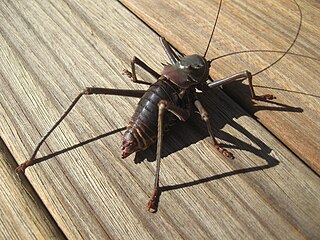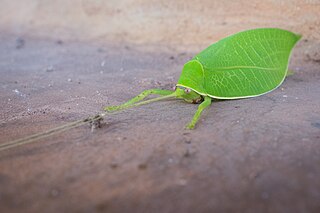The Nihoa conehead katydid is a species of katydid which is endemic to the Hawaiian island of Nihoa. It is one of the ten species in the genus Banza, all of them native to Hawaii, although it is the sister species to the remaining nine, and may belong in a separate genus. It gets its food mostly from plant leaves, but because of the low population, it does not do significant damage. Unlike Main Islands' species, whose males leap on the females before mating, the Nihoa variants sing to them. It is listed as a vulnerable species on the IUCN Red List, and as a "species of concern" under the Endangered Species Act.

The long-legged armoured katydid is a species of katydid found in Namibia, and also in the northern portion of Northern Cape Province, South Africa, and southern Angola. It may possibly occur in Botswana. It is found in semi-arid and arid habitats, including the Kalahari Desert and the Namib Desert. It is threatened by habitat destruction, but is widespread and is not considered to be endangered.
The Richtersveld katydid is a species of katydid that is endemic to the Richtersveld National Park in South Africa. It occurs in semi-arid habitats of the Karoo biotope. It is threatened by livestock grazing and climate change.

The antlered thorny katydid is a species of katydid that is found in South Africa and Namibia. It can be found in semi-arid and arid habitats, including the Kalahari Desert, the Namib Desert, and in the Karoo and Fynbos biomes.
The striped thorny katydid is a species of katydid that is found in South Africa, predominantly in the Karoo biome.

Alfredectes semiaeneus, or Alfred's shieldback, is a species of katydid that is widespread in the Western Cape and Eastern Cape of South Africa. It is found in lowland and coastal fynbos, up to 1400 m elevation. It is threatened with habitat destruction, but can be found in protected areas such as Baviaanskloof Mega Reserve and Tsitsikamma National Park.
Amyttacta is a genus of bush-crickets or katydids, which contains the following species:
Olszanowski's black-kneed katydid is a species of katydid that is endemic to the Western Cape and Northern Cape provinces of South Africa. It is mostly found in fynbos, but it can also be found in succulent and Nama Karoo biomes. Most records are from between 700 and 1,000 m.
Sopatas' black-kneed katydid is a species of katydid that is endemic to the Klein karoo biome of Western Cape province in South Africa. It is threatened by overgrazing by livestock and changes in weather patterns affecting its microhabitat.
The black-spotted false shieldback is a species of katydid that is only known from the male holotype collected from Mpumalanga, South Africa. It is threatened by livestock grazing and changing weather patterns disturbing its microhabitat.
Rentz's false shieldback is a species of katydid that is endemic to South Africa, and can be found in Limpopo, Mpumalanga, KwaZulu-Natal and Eastern Cape provinces.
The flat-necked shieldback is a species of shield-backed katydid that is endemic to the coastal forests and thickets of KwaZulu-Natal province in South Africa. It is threatened by cultivation, mining and tourism.

The Blue-legged Sylvan Katydid is a species of katydid, endemic to the South Africa region. IUCN classes it as Least concern due to its widespread distribution.
Aprosphylus hybridus, the Namibian black-kneed katydid, is a species of katydid that is endemic to southern Namibia.
Griffiniana duplessisae, or Duplessis' agile katydid, is a species of katydid in the subfamily Phaneropterinae. It is endemic to Cederberg Mountains in South Africa.
Transkeidectes multidentis, the Transkei Shieldback is a species of katydid in the family Tettigoniidae. The species is endemic to Port St. Johns in South Africa.
Arytropteris pondo, the Pondo flat-necked shieldback, is a species of shield-backed katydid. The species is endemic to South Africa.
Austrodontura castletoni, known as Castleton's Flightless Katydid, is a species of katydid in the family Phaneropterinae. It is named after the artist Gavin Castleton. The species is endemic to South Africa.
Naskreckia is a genus of South African bush crickets belonging to the tribe Meconematini.




